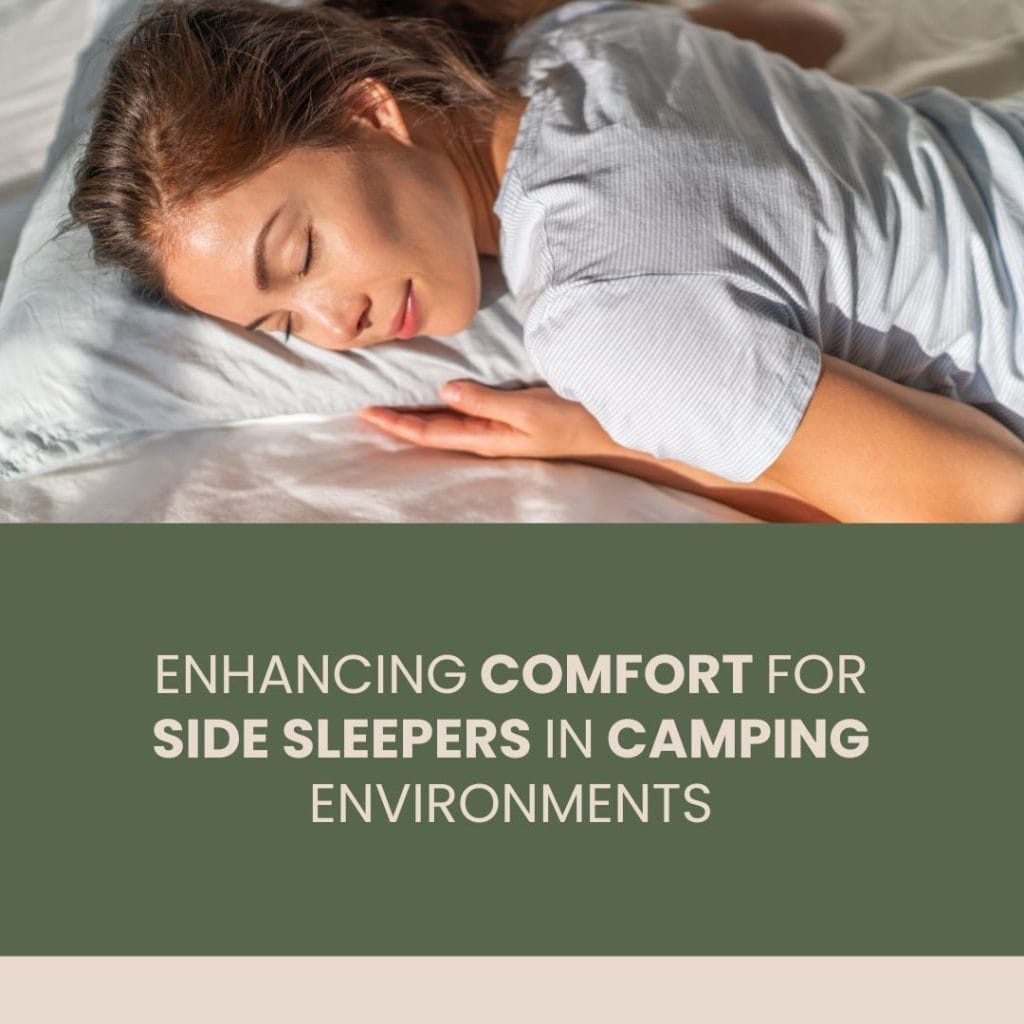Choosing the right camping pad can be a game-changer for a good night’s sleep in the great outdoors, especially for side sleepers. This guide will take you through the process of side sleeper pad selection, ensuring comfort, warmth, and restful sleep under the stars.
How to Select the Right Camping Pad for Side Sleepers
Sleeping pads serve dual purposes in providing a comfortable night’s sleep in the wild – they offer both cushioning and insulation. Here’s a quick guide on how to pick the ideal camping pad:
Types of Sleeping Pads: Understand the distinctions between the three primary pad types – air pads, self-inflating pads, and closed-cell foam pads, as well as their performance.
Intended Use: Identify the specific use of your pad. You might need it for backpacking, car camping, winter camping, or other activities.
Warmth (R-value): The pad’s R-value indicates its ability to resist heat loss to the ground. Pads with higher R-values offer greater insulation.
Sleep System: Your comfort at specific temperatures is dependent upon varied factors, including your sleeping bag’s temperature rating. Matching your sleeping bag with your pad correctly within your sleep system is crucial for ensuring warmth.
Features: Consider other vital features according to your requirement, such as weight, cushioning, size, and ease of inflation.
Types of Sleeping Pads
Air Pads
Air pads represent a versatile category of sleeping pads, ranging from ultralight options suitable for backpacking to plush, thick variants preferred for glamping. Contemporary air pads typically incorporate insulating materials or reflective substances to enhance warmth. Additionally, many air pads offer alternative inflation techniques, saving you from the manual effort of blowing air into the pad.
Pros: One of the notable advantages of air pads is their comfort and lightweight nature. They’re highly compact when packed, making them an ideal choice for those who need to save space. Their firmness can be adjusted by manipulating the amount of air in the valves, accommodating varying comfort levels. It’s important, however, to ensure that your chosen air pad has an appropriate R-value for the expected conditions.
Cons: On the downside, air pads, especially the lightweight and compact models, can be more expensive. They’re also susceptible to punctures or tears, although field repairs are possible with the right patch kit. Temperature fluctuations can make air pads lose firmness, so it’s advised to check and adjust the firmness before sleeping. Another concern is the moisture from breath that can get trapped inside, potentially leading to performance degradation or microbial growth. Utilizing a hand pump can help bypass this issue, as can storing the pad unrolled with valves open. Lastly, the noise produced by some air pads when moving can prove disruptive to some sleepers, emphasizing the importance of testing out pads in-store before purchasing.
Self-Inflating Pads
Self-inflating pads ingeniously blend open-cell foam insulation with air. Upon opening the valve(s), the foam expands, drawing in air automatically. You’ll find self-inflating pads designed specifically for either backpacking or car camping. Backpacking variants can be folded lengthwise and then rolled up for compactness, perfect for storage inside your pack. Conversely, car camping designs are simply rolled up without folding.
Self-inflating pads offer a wide selection in terms of warmth, size, and cost.
Pros: These pads score high on comfort and compactness relative to their performance. They boast excellent insulation and offer the flexibility of firmness adjustment by controlling the air inflow. Generally, self-inflating pads are more durable than air pads.
Cons: On the flip side, self-inflating pads are heavier and more costly compared to basic foam pads, and they don’t pack as compactly as air pads. While they can be punctured or ripped, field repairs are usually straightforward.
Closed-Cell Foam Camping Mats
These are essential camping pads made of dense foam filled with tiny closed air cells, typically designed to be rolled up or folded in a Z formation.
Pros:
- They’re lightweight, affordable, and durable, offering consistent insulation in all conditions.
- They’re resistant to punctures or leaks.
- They function well under other types of pads to enhance insulation and prevent punctures.
- They can be carried on the outside of your pack without fear of damage.
- They can serve as sit pads in camp.
Cons:
- They are less comfortable and relatively stiff and firm.
- They tend to be bulky.
When selecting a new sleeping pad, the key factor is the warmth of your overall sleep system. Also, consider your intended use:
- Car Camping: If you’re not limited by size and weight, opt for a thicker, larger mattress. Self-inflating pads are often good choices for car camping. Large inflatable air mattresses are another option if you prefer the use of regular sheets and blankets.
- Backpacking: For those valuing sleep comfort when backpacking, self-inflating or air pads offer a variety of thicknesses, durability, insulation value, and weight. Chair kits allow your pad to double as a comfortable seat with a backrest.
- Minimalist Backpacking: Low weight and small packed size are paramount. An ultra-light air pad is likely your best choice.
- Thru-hiking: Both low weight and durability are key. Closed-cell foam pads are an excellent choice, with many thru-hikers selecting a “short” or “3/4 length” foam pad to save weight.
- Winter Camping: An insulated, high R-value air pad is best for cold air temperatures and camping on snow. Use a closed-cell foam pad underneath an insulated, moderate, or high R-value air pad or self-inflating pad for additional insulation and protection against punctures or other damage. It also serves as a backup if the inflatable pad is damaged and cannot be repaired.
Sleeping Pad Warmth
Insulation and R-Value
Understanding the role of insulation and the R-value in sleeping pads is crucial for a comfortable camping experience:
- The critical function of sleeping pad insulation is to counteract body heat loss to the chilly ground. Various materials and construction techniques are used to optimize this heat retention.
- The R-value of a sleeping pad signifies its resistance to heat flow, hence the ‘R’ denomination. The higher the R-value, the superior the insulation provided.
- R-values for sleeping pads can range from under 2, indicating minimal insulation, to 5.5 or more, which denotes excellent insulation.
- A standardized methodology now exists for determining the R-values of sleeping pads, enabling comparisons across different brands, models, and types.
- The R-value scale is simple to interpret; for example, a pad with an R-value of 2.0 provides twice as much warmth as one with an R-value of 1.0.
- If multiple sleeping pads are stacked, the total insulation value can be calculated by adding their individual R-values.
Your Sleep System
Your Sleeping Pad and Bag Work Together
Your overall comfort and warmth during camping hinges on more than just temperature ratings. This is because a variety of real-world variables can alter your experience, including humidity, wind, the type of shelter you use, ground conditions, your clothing, and even your personal preferences. The central element to consider here is your sleep system.
A sleep system comprises three fundamental components: the sleeping bag, the sleeping pad, and the clothing of the sleeper. If you opt for a pad with less insulation in colder temperatures, your sleeping bag may not perform up to its temperature rating.
It is worth noting that a sleeping bag’s test rating is predicated on a person wearing long underwear and socks and sleeping on an insulated pad with an R-value of roughly 5.5. Consistency in these variables is necessary to achieve accurate measurements across all tested bags.
REI Co-op’s Magnusson Lab has carried out thorough testing to quantify overall sleep system comfort. They analyzed sleeping bags and pads with varying thermal performances, both individually and in different combinations. The table below offers recommended sleep system combinations based on expected nighttime lows, R-value of the sleeping pad, and the sleeping bag temperature rating.
Sleeping Pad Features
In this section, we will delve into the various features of sleeping pads that can significantly enhance your camping experience, particularly for side sleepers.
Weight of the Sleeping Pad
Ultralight sleeping pads, while excellent for backpacking, tend to be more costly. One can reduce weight by opting for pads with a mummy or tapered shape, which decreases the total volume and packs smaller. Short-length closed-cell foam pads are also known to be lightweight. If you’re backpacking with a partner, a dual-person lightweight sleeping pad can cut down on weight.
Length of the Sleeping Pad
Your pad should, at the very least, accommodate your shoulders and hips. Regular pads (typically around 72 inches in length) and long pads (usually 78 inches) provide insulation for your legs and feet, which is particularly beneficial during cold fall or winter trips. Short or 3/4-length pads (around 47 or 48 inches) are lighter and pack smaller. For additional insulation, you can place folded clothing or your backpack under your legs and feet.
Width of the Sleeping Pad
Most sleeping pads come in a standard width of 20 inches. However, for larger individuals or those who tend to move a lot during sleep, a width of 25 or 30 inches may be preferable. Ensure to consider the dimensions of your tent if you’re planning to fit two wider pads side by side. Some pads even offer larger side baffles or “rails,” which can cradle you during sleep to prevent you from rolling off. These are especially beneficial for children.
Inflation of the Sleeping Pad
Certain sleeping pads come with a high-volume inflation valve and a deflation valve, which expedite the inflow and outflow of air. Newer models may feature larger “neck” openings for faster inflation with fewer breaths. Pads with separate inflation chambers or layers provide added assurance; if one layer fails, the other will still offer some degree of cushioning.
Surface of the Sleeping Pad
For restless sleepers, pads with a textured or brushed-fabric surface are recommended. Such surfaces help prevent you and your sleeping bag from slipping off the pad during the night. They also tend to produce less noise.
Additional Sleeping Pad Considerations
- Pad Sleeves: Certain sleeping bags come integrated with a sleeve designed to hold a pad. This feature prevents both you and your sleeping bag from sliding off during the night. However, it is essential to check the sleeve width before purchasing a pad.
- Hand Pumps: For those who prefer not to expend breath after a long day of hiking, consider a pad with an in-built hand pump. Alternatively, you can invest in a bag-style hand pump which is lightweight and highly portable, weighing only a few ounces.
- Patch Kits: Backpacking often calls for a patch kit. These kits might come with your sleeping pad or could be available for separate purchase. It’s crucial to familiarize yourself with puncture repair before your trip, to be prepared for any nighttime repairs.
Conclusion
In conclusion, the process of Side Sleeper Pad Selection is crucial for a comfortable camping experience, especially for side sleepers. Various factors such as the R-value, the weight, length, and width of the sleeping pad, and its surface and inflation methods significantly influence your sleep system’s efficiency. Remember, your camping adventure can be as comfortable as you plan it to be, and choosing the right camping pad plays a pivotal role in that planning.






